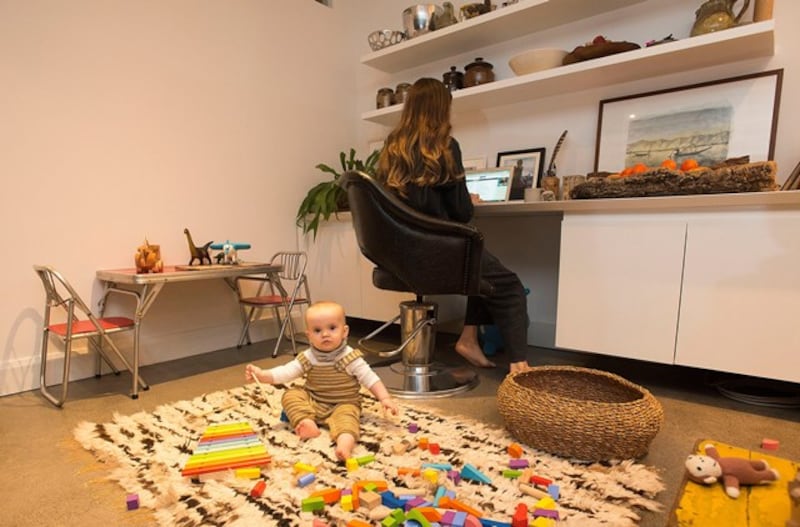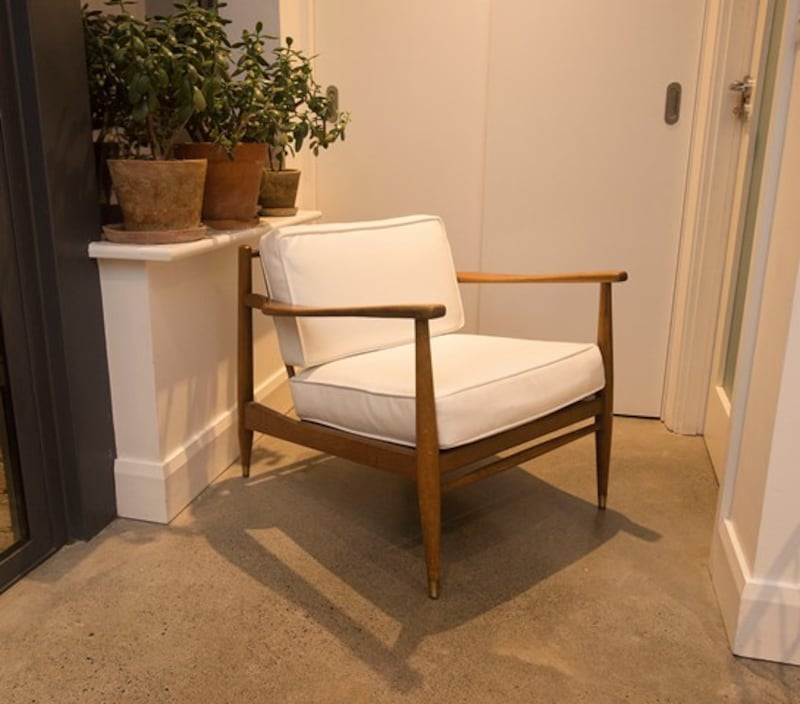It's not surprising when Claire Nolan reveals she spent more than 13 years living in LA, before deciding to return to her childhood village in Dublin. Her Glasthule cottage, with its polished concrete floors, mid-century classics and elemental design features, definitely feels more Hollywood hills than south Co Dublin.
“My mum had left me her home after she passed away when I was a teen, and I always knew I’d come back to it eventually but when I did [in 2013], I didn’t quite know what to do with it. It was your classic redbrick railway cottage – pretty poky and dark, with a galley kitchen and little natural light. Literally nothing had been changed in it since the ’60s,” says Nolan.
The cottage was quite the contrast to the airy, bright, open-plan Californian homes Nolan had been used to living in. So, to get her head around what direction to take the cottage in, she simply ripped away all the skirting boards and any crumbling parts and then painted everything white – the walls, the floors, woodwork. “I did nothing else and resisted buying anything and just lived in a white box for a year and a half. I wanted to let ideas evolve and get a sense of how the house changed with the seasons.”

Around this time, Nolan met her partner Dave O'Driscoll, who runs the popular family restaurant DeVille's in Dalkey, and when the couple moved in together, a clear vision for the cottage's next chapter started to evolve. "Dave is a closet architect and from working in the restaurant business, has developed a keen sense of how to make small spaces work and create a good atmosphere," says Nolan.
They enlisted Frank Murphy Construction and architect Peter White, who Nolan says were a dream team to work with. "We gave them a ridiculously long wish list for such a small, contained space. Lots of light was the main priority, as was an extended kitchen suitable for entertaining and two very enthusiastic cooks. We also needed a bigger master bedroom (as Dave's feet were touching the wall when he lay in bed), another bathroom downstairs, a small office space somewhere, a court yard to be created out of what was left of the garden, and we asked them to open up the central stairwell too. They delivered on all fronts," says Nolan.
The kitchen extension was the biggest part of the refurb and accounted for most for the budget too. “Although technically we didn’t add a huge square footage, the wall of accordion floor-to-ceiling windows, looking out to the courtyard, makes the space feel a million times bigger and makes the entire house infinitely brighter. We went for a polished concrete floor as I love the patina and the feeling of it underfoot and I’m a big fan of how it doesn’t need mopping every day,” says Nolan.
Before laying the floor, underfloor heating was installed, which Nolan says has transformed the house in winter. The kitchen units were a big splurge and Nolan spent a lot of time going to stone masons and working with the Design Yard on the mammoth quartz island. Master carpenter Rónán Hussey was drafted in to do all the woodwork in the kitchen and he also ended up working in every other room in the house. “Dave insisted on the massive SMEG range cooker and all the open shelving, as that’s what he’s used to from restaurant kitchens but I insisted on a few covered presses – and of course that’s where all the junk gets shoved into,” says Nolan.
The architect managed to squeeze in a new family bathroom downstairs to the side of the open-plan kitchen too, which, with two small children, Murph (2) and 10-month-old Deia, and a giant dog, Nolan says has been a lifesaver. It also means guests don’t have to traipse upstairs to go to the loo, an issue that drove Nolan nuts in the cottage’s original layout.

Salvaged materials
Although the extension is modern in essence, Nolan was keen to respect the cottage's heritage and seaside location, and didn't want the new part of the house to look incongruous, so with the builder's and architect's help, tried to use as much salvaged materials as possible. "All the outside bricks are recycled and sourced from Wilsons Yard in Northern Ireland, the granite plinths Frank found on an old site, the courtyard slabs my friend Karl Dunne, from The Stone Emporium, salvaged form the ends of jobs and the wood planks we got from an old cheese factory in Sligo," says Nolan.
The re-claimed theme runs throughout the house, as Nolan is an avid flee market shopper and is obsessed with finding treasure in thrift stores. "I've lugged stuff back from markets all around the world in my suitcase [Lisbon is her current haunt for interiors markets]. Or I ship anything that's too big, like the $5 Eames-style armchair I picked up in a garage sale in LA. You meet the most interesting people at the market stalls too. Last year I was at the Blackpitts market in Dublin and I spotted a painting of my old house in California. I started talking to the dealer, Paul Tuttle, about it and he's now become a good friend and introduced me to amazing artists like Brain Maguire and Patrick Callaghan and got me great deals on their paintings too."
And it's not just markets Nolan stalks – she spotted her dream marble dining room table in the offices of Lost Weekend in Dún Laoghaire a few years back and fell in love with it. "I've been begging them to sell it to me forever and they finally gave in a few months back. I'm a big believer in waiting for the things you really want, rather than buying a piece just to fill the gap. Anything I buy, I plan to keep it and use for life, so it's got to be worthy," says Nolan.
When asked if she learned any lesson from the renovation process, Nolan responds: “Never go on holidays when you have builders in. You may think you’re doing everyone a favour by getting out of the way, but you just end up coming back to chaos. I definitely think renovations need to be a collaborative process between the owner and contractors and popping into the project every day is critical. Micro-managing builders I think will just backfire too, but finding mutual boundaries and motivations makes for the best end result.”











